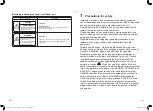
� 7 �
13-EN
14-EN
■
Refrigerant piping
R410A refrigerant
CAUTION
•
Incomplete flaring may cause refrigerant gas leakage.
•
Do not re-use flares. Use new flares to prevent refrigerant gas leakage.
•
Use flare nuts that are included with the unit. Using different flare nuts may cause refrigerant gas leakage.
Use the following item for the refrigerant piping.
Material : Seamless phosphorous deoxidized copper pipe.
Ø6.
4
, Ø9.52, Ø12.7 Wall thickness 0.8 mm or more
Ø15.
9
Wall thickness 1.0 mm or more
REQUIREMENT
When the refrigerant pipe is long, provide support brackets at intervals of 2.5 to 3 m to clamp the refrigerant pipe.
Otherwise, abnormal sound may be generated.
4
Installation conditions
■
Before installation
Be sure to prepare to the following items before
installation.
Length of refrigerant pipe
Model
Length of refrigerant
pipe connected to
indoor / outdoor unit
Additional refrigerant
SP122
SP182
16’5” - 65’7”
(5 - 20 m)
None
*65’7” - 164’1”
(20 - 50 m)
Add 0.22 oz/ft (20 g/m)
of refrigerant for piping
that exceeds 65’7”
(20 m) up to 164’1”
(50 m).
* Caution during addition of refrigerant
Max. amount of additional refrigerant is 1.8 lbs
(800 g).
Charge the refrigerant accurately. Overcharging
may cause serious trouble with the compressor.
* Minimum refrigerant pipe is 16’5”(5 m).
This may cause a malfunction of the compressor or
other devices.
Leakage test
1. Before starting an leakage test, further tighten the
spindle valves on the gas and liquid sides.
2. Pressurize the pipe with nitrogen gas charged from
the service port to the design pressure (4.15 MPa)
to conduct an leakage test.
3. Check for gas leaks using a leak tester for the HFC
refrigerant.
4. After the leakage test is completed, evacuate the
nitrogen gas.
Evacuation
•
To evacuate system, use a vacuum pump.
•
Do not use refrigerant charged in the outdoor unit
for evacuation.
Electrical wiring
•
Be sure to fix the power wires and system
interconnection wires with clamps so that they do not
come into contact with the cabinet, etc.
Grounding
WARNING
Make sure that proper grounding is provided.
Improper grounding may cause an electric shock.
For details on how to check grounding, contact the
dealer who installed the air conditioner or a profes
sional installation company.
•
Proper grounding can prevent charging of electricity
on the outdoor unit surface due to the presence of a
high frequency in the frequency converter (inverter)
of the outdoor unit, as well as prevent electric shock.
If the outdoor unit is not properly earthed, you may
be exposed to an electric shock.
•
Be sure to connect the earth wire. (grounding
work)
Incomplete grounding can cause an electric shock.
Do not connect ground wires to gas pipes, water
pipes, lightning rods or ground wires for telephone
wires.
Test run
Turn on the leakage breaker at least 12 hours before
starting a test run to protect the compressor during
startup.
CAUTION
Incorrect installation work may result in a malfunction
or complaints from customers.
1131701101-00_S01_297x210_60p_S_p70_220426.indd 7
26/4/2565 11:41:09







































